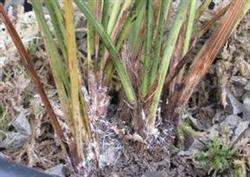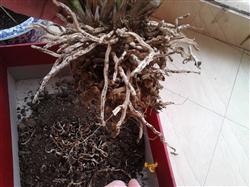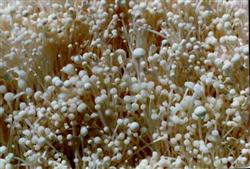Control methods of Orchid Sclerotinia sclerotiorum (White Silk Disease)

[symptoms] the disease began in the near-ground part of the orchid plant, showed wet rot in the form of water stains at first, then turned brown to black-brown rot, extended to the middle and upper part of the leaves, and became brown or grayish brown necrotic, and in severe cases, the whole leaf filaments withered and died. After a clump of bluegrass was infected, the tillers in the same basin could not be spared. When the necrotic surface and soil surface of the diseased plant were examined, white silk-like filaments (mycelium) or sclerotia (sclerotia) could be seen. [pathogen and characteristics of the disease] the pathogen is a small sclerotia of the subphylum semichi [Sclerotiumrolf-siiSace.], and its sexual stage belongs to the genus Artemiella of the subphylum basidiomycetes [Atheliarolfsii=Corticiumrolfsii=Pelliculariarolfsii]. The pathogen overwintered with sclerotia in the soil or compost, and the germinated hyphae spread in the soil the following year, invading from the base of the orchid leaves. Bacteria check has strong resistance to adverse environment and can survive in the soil for several years. It can be spread by running water, irrigation water, Rain Water sputtering and fertilization. The ecological conditions of sour soil, high temperature and humidity are beneficial to the disease. [prevention and control methods] change the basin soil with ①. Valuable variety pots can be disinfected with a pressure cooker for more than 2 hours, or try 82 Trichoderma biological agents to mix soil (15g / pot), or try 1000 times of soil bacteria dewatering agent to apply basin soil before colonization. The newly diagnosed strains of ② can be sprayed with 200x solution of Jinggangmycin, 300x solution of Tian'an water agent, or 400x solution of multi-well suspension.
- Prev

Control methods of Orchid ants
Some flower lovers who are beginners to raise orchids often do not know much about the habits of orchids and find it difficult to raise orchids well, burn their tips and pour seedlings, and there are only a few dead piles left after a year or two. Most of the reasons are caused by the rot of Langen. As the saying goes, orchids grow roots first. The roots are good, the leaves are strong, and the flowers smell good. To cultivate a pot of orchid.
- Next

How to use needle mushroom waste
The abnormal phenomenon often occurs during the period of mushroom growth due to improper management. The causes and preventive measures of the main problems reflected by the bacteria farmers are introduced to everyone for reference. 1. The strain block does not germinate. After inoculation, the strain does not germinate, and the mycelium turns yellow and withers. Causes: ① The strain is stored for too long...
Related
- Fuxing push coffee new agricultural production and marketing class: lack of small-scale processing plants
- Jujube rice field leisure farm deep ploughing Yilan for five years to create a space for organic food and play
- Nongyu Farm-A trial of organic papaya for brave women with advanced technology
- Four points for attention in the prevention and control of diseases and insect pests of edible fungi
- How to add nutrient solution to Edible Fungi
- Is there any good way to control edible fungus mites?
- Open Inoculation Technology of Edible Fungi
- Is there any clever way to use fertilizer for edible fungus in winter?
- What agents are used to kill the pathogens of edible fungi in the mushroom shed?
- Rapid drying of Edible Fungi

